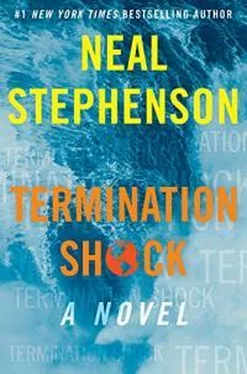“T.R., what do you mean ‘the justice that they are due’?” Saskia asked.
“The size of it. The sheer amount of steel in the ground. The engineering. The presence , Your Majesty, the physical mass and reality of it. Every strand of rebar was drawn out in a steel mill. Where’d the heat come from? Burning things. The cement was produced in kilns, biggest things you ever seen. How do we keep the kilns hot? Burning things. We put the steel and the concrete together to make these things, these freeway interchanges, just so cars can run on ’em. How do we keep the cars moving? Burning things.”
“Putting CO 2into the atmosphere,” Saskia said.
“Oh yes.”
“It is not sustainable.”
“With all due respect, Your Majesty, it is as sustainable, or as unsustainable, as your whole country. Later we can talk about how to sustain what matters to us. Now, hang on a sec, this calls for focus.”
What he focused on next was slaloming his drone through the huge pillars he’d just been describing, cutting under ramps and looping through cloverleafs. Finally he pulled out into the open and swooped them up to an altitude where they could look down on the Katy Freeway skimming beneath them. It had become even wider, if such a thing were possible. “Twenty-six lanes,” T.R. said, as if reading her mind.
Right now those lanes were only spattered with vehicles, as many businesses, schools, and activities had been shut down because of the hurricane. But Saskia noticed the bubble of her drone getting dark again, signaling another AR sequence about to start. “Not much going on today,” T.R. remarked, “so I’m gonna take you on a little trip down memory lane. This is the same day of the year, same stretch of freeway, as it was back in 2019.”
As he said it, the twenty-six lanes of the Katy Freeway suddenly filled up with cars and trucks, countless thousands of them, moving along at moderate speed—not quite a traffic jam, but still with enough brake lights igniting here and there to temper the flow. A motorcycle weaved through, going twice as fast as everyone else, using the bigger vehicles as pylons. The illusion was powerful even though the rendering had been simplified—every semi was a clone of a simple featureless semi model, and the same was true of cars, vans, pickups, and so on. But if anything that simplification made it easier to “read” the data. T.R. was showing them, in a way that was easy to grasp, exactly how much traffic had passed down this freeway at this time of day on this day of the year in 2019.
“2020,” T.R. said, and the display shifted. This time traffic was sparser, and moving faster. “The first pandemic. Now, 2021.” Another shift. More traffic moving more slowly—there was a traffic jam. “2022.” It sped up. “2023. 2024.” The lanes emptied out. “That was a hurricane year, just like this one. 2025. You’ll notice a change taking hold,” T.R. said, as the years ticked upward, “as self-driving cars take over. In heavy traffic, they drive closer together, almost like they join together into a train. So we can fit more vehicles onto the same stretch of pavement and those vehicles are all going faster—much greater throughput! Here, I’ll flip between 2019 and 2029 and that’ll make it easy to see.”
He did so, and it was. The flow depicted in 2019 was gappy and spasmodic. Ten years later the cars were moving the way everyone was accustomed to nowadays, following one another closely, adapting smoothly to lane changes and merges. Saskia had lived through that transformation and was aware that it had happened but had never seen it demonstrated so vividly.
“So just when the Greens might be fixing to dance on the grave of the automobile, software crams twice as many of the little buggers onto the roads, makes the commute safer and easier for everyone. Guess what? People buy more cars! Burn more fuel. T.R. Mick’s makes more money, builds more mobility centers on all the new highways getting laid down to carry all those cars.”
The virtual display faded, the real world brightened. This whole time, the swarm had been humming eastward above the centerline of the Katy Freeway fast enough to overtake and pass the speediest vehicles. And yet, for all the distance they had covered, nothing had changed. The more Houston they put behind them, the more just rolled up over the western horizon to replace it. Like an infinite conveyor belt of mega-city.
“ What kind of money we talking? That’s the question my daddy and his daddy always used to ask, looking at an oil field, trying to work out how much to pay, how much to invest. What kind of money we talking?”
They’d passed over an interchange the size of central Amsterdam, where the Katy crossed one of the inner, older ring roads. Now they were looking several miles out toward another, much newer and larger interchange. Saskia began to see features she had noticed lately on maps: the tall corporate-campus buildings of Energy Corridor, and the two large regions shown on maps as bodies of water. On satellite imagery they looked like forested parks. Today they actually did look like reservoirs, albeit very untidy ones. Instead of placid open water their surfaces were grubby with trees, and instead of neatly staying within bounds they had burst their levees and invaded the suburban developments that had ill-advisedly been constructed on surrounding land.
“The maps lie,” T.R. said, as they slowed, banking rightward off the freeway and approaching one of those reservoirs. “I’ll show you what the maps have to say about what we’re looking at right here.”
Once again the AR system did its thing, this time by superimposing a plain old Google Map on the landscape. This was the bare-bones version, like something from the first decade of the twenty-first century. No satellite imagery, no traffic data, no overlays of any kind. Just roads in white, dry land in beige, and bodies of water in light blue. “Looks pretty tidy, don’t it?” T.R. scoffed. “Who makes these things? Anyone who lives down there knows that ain’t the real picture. Here’s the real picture.”
The map now began to fluctuate in a way that at first was visually jarring and difficult to follow. But as time went by Saskia understood that this was a collage that someone had assembled from aerial imagery. It was a mixture of satellite and drone photography showing the “reservoir” and its environs as they had actually looked over the last few decades. Early on, the coverage was spotty—they only had images at intervals of weeks or months, so the change from one to the next was jarring—but soon enough (as years went by and satellite coverage became ubiquitous) it smoothed out to the point where you could watch it like a movie. And what the movie showed was the reservoir throbbing like a living thing, an organic blob under a biologist’s microscope. Sometimes it shrank to nothing and all you saw was trees. But then in the aftermath of a heavy rain it would form puddles in the low places that would grow explosively over a few hours or days to fill the neat boundaries circumscribed by the levees. Every so often it would break out and become an even larger body of water with houses projecting from its surface. As years went by, some of those houses disappeared. T.R. wanted them to notice that. He led the swarm toward the edge of one such neighborhood and let them see how a swath of homes had been lost to the floodwaters of Hurricane Harvey. “A hundred and twenty-five billion,” T.R. said. “That was the price tag for Harvey. Second only to Katrina, which was a hundred and sixty-one. So that’s what kind of money we’re talking. Damages on the order of one or two hundred billion, inflicted on this city suddenly and at unpredictable times.”
He ran the simulation forward over a couple of decades, then back, then forward again. Saskia sensed he must have his finger on a scroll bar in some UI, racking it up and down across the years. This made obvious something that might have gone unnoticed if they’d watched it more slowly, which was that the neighborhood was moving vertically upward—actually gaining altitude, here and there, in fits and starts. More precisely, the level of the ground itself stayed the same but the houses were rising into the air, new foundations being slipped under them. “We see the rise of the house-jacking industry,” T.R. remarked. “Here are its fruits.”
Читать дальше

![Нил Стивенсон - Криптономикон [litres]](/books/23868/nil-stivenson-kriptonomikon-litres-thumb.webp)







![Нил Стивенсон - Лавина [litres с оптимизированной обложкой]](/books/414066/nil-stivenson-lavina-litres-s-optimizirovannoj-ob-thumb.webp)
